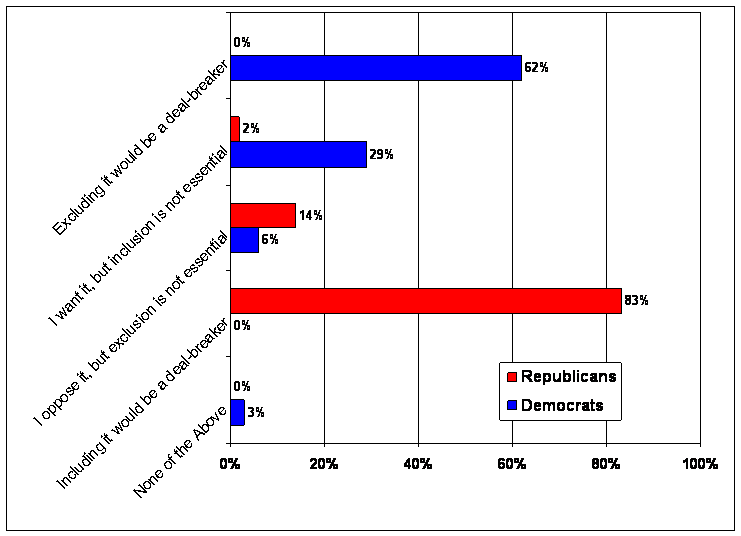The public plan option was expected to be the most politically contentious issue in the health reform debate – and it now clearly is. MoveOn.org has declared it the #1 priority in health reform, and the National Journal’s most recent Insiders Poll has put forth some striking numbers about the clear partisan divide on this issue. The question they asked in the poll published in their May 23rd issue was “What is your view of including a new public insurance plan in health care reform?” And the results are shown in the graph below:
With 62% of Democrats saying they MUST have it, and 83% of Republicans saying they CANNOT have it, the public plan is clearly a partisan line in the sand.
The debate over the public plan option is clearly a political weapon and not just a policy difference, because exactly what the public plan option would be hasn’t been decided or even extensively discussed. For example, would it be modeled after Medicare? Medicaid? The Federal Employee Health Benefits Program? (FEHBP, like many large employer plans, is a menu of private insurance options, none of which are actually run by the government.)
The political nature of the “dialogue” over this issue is evident from the some of the quotes from the Insider Poll participants:
Democrats:
“Without a public plan, it is total capitulation to the insurance industry. And we know what they have done to us.”
“The public deserves the same service that members of Congress and federal employees receive, a public health insurance option.”
Republicans:
“Why on earth would we want another health care program modeled after Medicare and Medicaid? Because they are such stellar models of well-run, top-notch health care? Not!”
“The ultimate goal of a public insurance plan is to create a single-payer system.”
“Please, please push for this, Madam Speaker, Leader Reid. Beating you over the head with government-run, rationed health care is pure joy.”
Is Compromise Possible?
Some of the interesting compromises around a public plan option include having the public plan be a “fall-back” that would only be created if certain benchmarks for choice, (and possibly cost), are not met. (Such a fall-back provision was included in the Medicare Part D law to ensure that there were sufficient choices of Medicare Part D plans in all parts of the country.) And FEHBP, which as noted above has been mentioned as a model for the public plan option, might not face the same level of criticism about it leading to a national single payer plan, because – like the Commonwealth Connector in Massachusetts – it is comprised of choices of private insurance plans….and I don’t recall hearing Republican Members of Congress calling for eliminating FEHBP.


[…] good idea to me. It is far too early to tell but it is not inconceivable that this is the necessary compromise. We shall […]
[…] Miller of the Health Policy and Communications blog looks at a new National Journal “Insider’s Poll” that asks experts, […]
The fallback option seems so sensible. As far as I can tell, it is getting only a little bit of attention. I wonder if it will be the necessary compromise. It is hard to argue against it if one can define a set of triggers for it that are generally agreeable (and that may be the rub).
[…] good idea to me. It is far too early to tell but it is not inconceivable that this is the necessary compromise. We shall […]